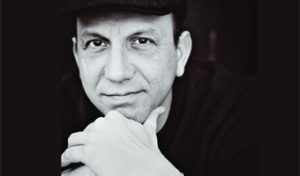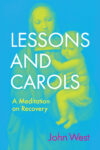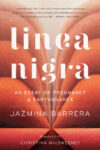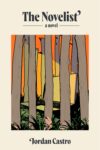Steven Church’s fifth book of creative nonfiction, One with the Tiger: Sublime and Violent Encounters Between Humans and Animals begins with David Villalobos’s leap into the tiger cage at the Bronx Zoo:
David knew what was about to happen: the guide slowed the cars, trying to spot Bashuta in the brush, and pointing her out to the other visitors. David waited for his cue, for the opportunity. As his car pulled up alongside the paddock, Villalobos suddenly stood up. He climbed up on the the edge of the car, reaching up and bracing himself against the roof with his palms. He balanced briefly on the railing, rolling on the balls of his feet to get his balance right. Then he leaped, clearing four strands of barbed wire sixteen feet down into the tiger’s cage.
David landed on all fours, “like a cat,” he would later brag, then crumbled and rolled to the side.
People on the train gasped, pointed, and screamed.
Imagine the terror of witnesses. Think of how that moment must have shimmered and buzzed, electric with fear. I’ve tried to imagine David’s leap, perhaps as a way to get closer to understanding it. I’d come to New York to try and retrace his steps. I’d come to the zoo to find David.
Throughout these linked meditations Church invites readers to look past easy answers and instead “dwell in the unknowable” of man’s desire to interact with wild animals. Steven and I talked about the origins of One with the Tiger, research as an essayistic pursuit, Mike Tyson, fatherhood, his journal, The Normal School, and his next book.
James Chesbro: In the first section of One with the Tiger you mention becoming “somewhat obsessed” with the first reports of David Villalobos jumping from the monorail into the habitat of a 400 pound Siberian tiger at the Bronx Zoo, “losing” yourself “down rabbit holes of research into similar stories.” At what point did the research move you to begin writing, and at what stage of writing did you first think this material could become a book?
Steven Church: The heart of this book, really, were some older essays that didn’t quite fit into other book projects I was working on—chapter/essays like, “Speaking of Ears and Savagery,” and “Fight, Bull,” mixed in with a longer project about zoos and some older material on bear attacks that had been sort of orphaned during the process of building other books. The story of David Villalobos had the effect of catalyzing whatever alchemy goes into making a book and at some point I realized that it was my essaying into his story that tied together these other essays and obsessions, while also pushing me to do more research and writing. But as with all my books, the realization that it is a “book” often comes later, near the end, when the book tells me what it wants to be.
The day after Villalobos’s leap you mention the New York Daily News article titled “Zooicide.” You write that “It’s too easy to just say he was ‘mentally ill’ and call his leap a ‘suicide attempt.’ It’s too vague and meaningless, really, and doesn’t address the spectrum of possibilities.” This territory of pushing beyond easy answers makes up the vast majority of terrain where you dwell in the pages of this book. How did you find your way beyond the “vague and meaningless” and onto the paths of meaning?
I think I found my way through imagination, speculation, and an effort to immerse myself and inhabit these stories. I tried to write the “I” out of it at times, to get close to the subjectivity of the experience itself, even while recognizing that this experience is mediated through layers of meaning—factual, journalistic, artistic, etc. I suppose most of what I try to do as an essayist is to constantly push beyond the easy answers, to find the deeper meaning and connection, or to simply invite a reader to dwell in the unknowable.
While writing about Mike Tyson, you say the “Tyson phenomena—part real, part fiction—is as American and immortal as anything. We love our violence, our monsters and our stories of redemption.” In the same essay you pose the question of whether or not people can “try to understand savagery without sympathizing or forgiving it.” Do you think Americans who remember Iron Mike in his prime can do that?
I’m not really sure. I mean, Mike Tyson was an undeniable phenomena when he burst upon the scene. He was different. He was the embodiment of unchained rage and savagery, and so many of us LOVED it. He was punk rock with his black shorts, black socks, black shoes. He didn’t dance or preen, didn’t wear colorful shorts emblazoned with corporate logos. He just destroyed his opponents, and he seemed “real” in the way that other boxers were not. He was, in my humble opinion, the last of the truly great heavyweight fighters or at least the last one that people either loved or loved to hate. I mean, Evander Holyfield, who took his title, was just boring and uncomplicated. I’m sorry but that’s true. There’s nothing sublime or really fascinating about Holyfied. (And now, with this Mayweather vs. McGregor farce passing as a “fight,” we’re expected to be invested in a couple of preening roosters who lack any real nuance or conflict—two fighters, btw, that Tyson would’ve absolutely destroyed in his prime.) Anyway, I suppose I always felt that Holyfield didn’t beat Tyson; Tyson beat himself and became a kind of tragic figure . . . but now I’m rambling because I’m not sure I can answer your question. I guess I’m not sure if other people want to intellectualize Tyson as I do, or try to see him as something bigger than the sum of his actions, crimes, arrests, losses, and wins—or if that’s even a good idea.
Throughout One with the Tiger you chronicle numerous failed attempts at contacting people associated with his Villalobos’s leap trying to get more information from them. Including these attempts, even though they didn’t yield much if any information seemed necessary to the narrative journey that holds the various threads of your book together. Can you talk about your decisions to include these interactions in the manuscript?
At first I was really frustrated and stymied by the unwillingness of people to talk with me; but then I realized that my frustrations, my search, could also be part of the “stakes” of the book and something with which a reader can identify. I guess I also wanted to show that, while I tried to act like a journalist at times, I’m ultimately an essayist who isn’t very good at basic journalistic practices. I failed repeatedly. I guess it was perhaps also a way to ask permission from the reader to go off into the land of imagination sometimes—to say, hey, I did the best I could with the facts, so now I gave to imagine and fill in the gaps.
At one point you write, “The facts are just a window that opens into everything else.” Can you say a little bit more about that? Do you ever do any kind of news-article-prompts with your MFA students at Fresno?
Well, without trying to get into too much deep water, I think what I mean is that the factual truth of an event like David Villalobos’s leap into a tiger cage is only one layer of truth and meaning, and it’s a layer that is quickly covered over with other layers of meaning-making. Journalists are trained to investigate the objective factual truth of an event, while essayists are perhaps trained to investigate the subjective shifting artistic truth of an event. And I’ve done some things to push students out of their own comfort zones a bit—such as requiring an immersive journalistic essay or a hermit crab essay—and I’ve asked them to write about scenes in a favorite bad movie, encouraging them to engage with other texts out there in the world; but I also try not to be too prescriptive or assume that just because something works for me, that it will necessarily work for others.
Part six is titled “Father and Daughter,” where you reflect on different visits to your local zoo. Would you consider any of those visits seedlings to your approach to the subject of encounters between humans and animals? You call the Fresno Zoo a place “fraught with contradictions.” The animals are in cages and yet it’s “a place of great comfort and escape for my children and me.” I’m wondering how you would characterize the ways in which your fatherhood contributed to writing this book.
I think as an essayist, I’m always considering the question, “Who cares? What’s at stake?” and for me, at least, one level of stakes in most of my life is my relationship with my kids and my role as a father. I’ve often said that of all the roles I inhabit in my life (writer, professor, editor, husband, friend, etc.) it’s my role as a father that is fraught with contradictions, the one role defined by both doubt and self-confidence. I like to say that kids are great “essay engines” because they’re constantly forcing you to re-evaluate yourself, to make connections between your past and your present, to explain what you actually mean when you say something. But it’s also true that, here in Fresno, where we have one of the worst ratios of public spaces to population in the country, the zoo was a “safe space” for my kids and me, a place to explore without any real goal in mind. I spent a lot of time with both of them, but especially with my daughter as I was her primary daytime caregiver until she went to elementary school. We spent a lot of time at the zoo just wandering around aimlessly, sort of essaying our way through this ever-changing landscape of life and death, captivity and wonder.
As one of the founding editors and the nonfiction editor of The Normal School, what exciting things are happening at your journal that you’d like to tell people about?
Oh, man, we have a LOT of exciting stuff happening with The Normal School in addition to our regular line-up of amazing fiction, nonfiction, and poetry in EVERY issue. First up, I’m editing an anthology of essays from the first 10 years of the magazine called The Spirit of Disruption; and it will be out next Spring from the San Francisco based indie-publisher, Outpost19. In addition, we’ll soon be launching a new partnership with Outpost19, The Normal School Book Series in Nonfiction, and I’ll be the Series Editor. The Normal School will not only serve as a kind of “talent scout” for the series, but the staff will also be involved in reading, selecting, and promoting the chosen manuscript. We’re very excited about this. For years people have been asking me when we were going to start publishing books and I’m incredibly lucky to be working with Jon Roemer at Outpost19 on this new endeavor.
Your next book, I’m Just Getting to the Disturbing Part, comes out in the spring of next year. What’s that book about?
It’s about werewolves. And being a tour guide for giant holes in the earth. Or only one of those things plus the weird drama of life in the “service industry” and the weird service industry of fatherhood, especially the electric fear that surges through nearly every experience when you’re trying to occupy the roles of father, writer, tour guide, husband, and self. This book contains some of my oldest, most humorous, and favorite essays mixed in with some more recent explorations, and it’s also probably one of my more narratively suspenseful AND formally innovative books.
James M. Chesbro’s essays have appeared in The Writer’s Chronicle, Huffington Post Books, The Washington Post, Essay Daily, and America, among others. His essays have been selected as notable works of literary nonfiction by The Best American Essays series four times.
This post may contain affiliate links.








